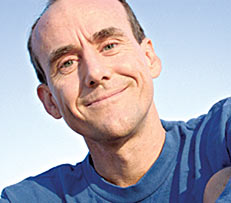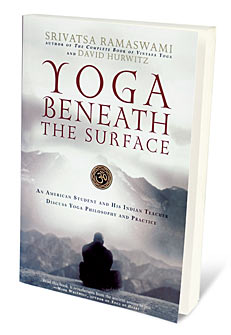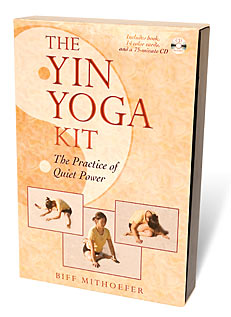STRETCH AND FLIRT Many women are familiar with the seedy character in the “Inappropriate Yoga Guy” video, above.
The Phenomenon of Inappropriate Yoga Guy
THE words “Do you come here often?” are not sweet nothings when you are going into final relaxation during a yoga class. Nor do most yoga practitioners welcome someone who flirts shamelessly as mats are positioned during the lull before the teacher arrives.
Now, a popular online video starring a lech named Ogden has the yoga community chuckling in recognition and talking about the problem of men who come to studios in search of phone numbers rather than enlightenment.
The comedy sketch, aptly named “Inappropriate Yoga Guy,” has racked up nearly 1.8 million views since its debut on YouTube in June — no doubt the biggest hit to date for GoPotato.tv, an online comedy network in Los Angeles, which produced the video starring Avi Rothman.
Wearing a goofy headband, Ogden “Oms” far too loudly, brags about the retreats he has attended in Nepal and Mexico, and makes eyes at Kimberly, a buxom long-haired beauty, during class. He even grabs her hips to perform an adjustment (a correction usually done discreetly by a teacher).
Hilarious as it is, “Inappropriate Yoga Guy” raises a delicate issue that the video now has people discussing openly: that while the majority of yogis are respectful and friendly, a handful of interlopers use classes to hit on a succession of lithe, toned regulars. More than a dozen students and teachers and six studio owners interviewed for this article said they knew an Ogden-type character.
“There’s always a guy who wants to put his mat next to the hot girl,” said Hillary Raphael, 31, a writer based in Washington. Ms. Raphael, in her 20 years of practice, has found inappropriate yoga guys so prevalent in studios that she wove them into her novel, “Backpacker,” to be published next month by Creation Books.
Yoga regulars aren’t prudes; rather most of them abide by some unspoken rules (such as no talking or no looking around) that some newcomers unwittingly break in pursuit of comely dates.
Ms. Raphael described an experience she had during a vinyasa class she used to attend at Sal Anthony’s Movement Salon in Manhattan. “All you could hear was people’s steady breathing,” she said. “Yet this guy next to me was trying to strike up a conversation the whole time.
”The man, who was in his early 40s, used a loud stage whisper to ask about Ms. Raphael’s hobbies. “You could hear people’s breath sagging and stopping,” she said. “They couldn’t believe it.”
Other men are even bolder. Stephanie King, 40, a jewelry designer who practices yoga five times a week in Los Angeles, said she has had cringe-worthy encounters during her 20 years of practice. In one instance, a fellow regular Ms. King had met in passing approached her after a power yoga class and asked if she had enjoyed her practice. She had. Then, apropos of nothing, he asked if she wanted to be his lover.
Ms. King calmly told the man she would think about it. After a particularly intense practice, it can take a moment to regroup and get your social bearings. But once at her car, she called him and said, “I just want to let you know that I’m going to pass on being your lover.”
Her politeness masked annoyance. “I was put out because he just ruined my blissful feeling after class,” she said.Another time, an attractive man stretched his hand out during a floor twist until it rested on Ms. King’s breast; he removed his hand when asked.
“If you’re going to a yoga studio to pick up girls, or boys for that matter, you’re not doing yoga,” said Lama Sumati Marut, 54, president of the Yoga Studies Institute in Tucson.
Yoga, done seriously, is a discipline designed to achieve enlightenment in this lifetime, he said.
Needless to say, not everyone who drops into a yoga class is on a spiritual path. Consider the women at Yoga Works in Midtown Manhattan who can’t help flirting with Steve Eisenberg, much to his delight. “It’s a very social environment,” said Mr. Eisenberg, 38, a consultant who helps companies create digital media.
“They’ll say, ‘I’ve seen you around,’ and start chatting,” added Mr. Eisenberg, who is single and said he enjoys the attention.
The question is: What responsibility does a studio or a teacher have if one student is making another uncomfortable?
Some instructors like Kelly McGonigal, 29, who teaches at Stanford University and at the Avalon Art and Yoga Center in Palo Alto, Calif., take matters into their own hands.
“I had a popular class that some of the regulars stopped showing up to because a guy was relentlessly hitting on them,” said Dr. McGonigal, who has a Ph.D. in psychology and edits the International Journal of Yoga Therapy. She confronted the overeager student in question, and he backed off, saying it was all a misunderstanding.
“He didn’t realize that he was perceived as hitting on people when he invited them out to dinner or to parties,” she said.
Teachers, who are most likely to notice misbehavior, are the ones who should aim to make their classes safe havens free of distractions, said Judith Hanson Lasater, president of the California Yoga Teachers Association.
But in Dr. McGonigal’s case, that was not possible. “It was happening outside of the classroom,” she said.
It was only after a chance encounter on the street with two of her students that Dr. McGonigal found out “they had stopped coming because they didn’t want to see that guy.”
Having an outlet for complaints would help, said Dr. Lasater, who has a Ph.D. in East-West psychology.
Most studio staff agree that teachers dating their students is a difficult situation at best, and exploitative at worst. But there is little consensus about student come-ons. After all, is asking for a phone number in a yoga studio any different than swapping digits across treadmills?
Some say yes. Trolling for dates at yoga studios strikes a lot of regulars as tacky and reprehensible — even to some bachelors.
“Why would I stare down a girl in yoga class?” said Christopher Porzio, 36, a photographer in Williamsburg, Brooklyn, who practices at least four times a week. “People are coming to help themselves, to get more comfortable. Why rob them of their comfort?”
For others, it is a gray area. Fred Busch, 32, the owner of Miami Yogashala, knows that some male and female members actively scope out dates at his center. He is uncomfortable with it but, he said, “there’s no law against talking to someone.”
To confuse matters, some centers foster dating. For instance, the Joy Yoga Center in Houston offers singles classes once a week, an hourlong vinyasa practice followed by snacks and socializing. Surprisingly, or perhaps unsurprisingly, two-thirds of the participants are men.
The Flow Yoga Center in Washington already has a class on Thursday night nicknamed “social flow,” after which students go for cocktails, and has plans for speed dating in its tea lounge.
But the downside is that one student glomming on to another can dampen a studio’s atmosphere. That is what happened at the Dallas Yoga Center in Texas, when a 40-something man’s overtures disturbed some female students. As soon as studio staff noticed the man’s unsettling behavior, the director, David Sunshine, took the man aside for a heart-to-heart. “We don’t mingle the dating scene with yoga,” Mr. Sunshine said. “We focus on quality yoga teaching.”
Plenty of singles don’t mind having another yogi propose dinner. Elana Wertkin, 31 of Park Slope, Brooklyn, went a few dates with a cute guy she met in a neighborhood class.
“We walked out at the same time and he said ‘Let’s go for a smoothie,’ ” said Ms. Wertkin, a documentary film producer.
But her interest in him was soon cut short. On their third date, he confessed that part of the reason he loved yoga class was watching women lie on their backs, legs spread.
“I had to stop going to that studio for a long time after that,” Ms. Wertkin said.












